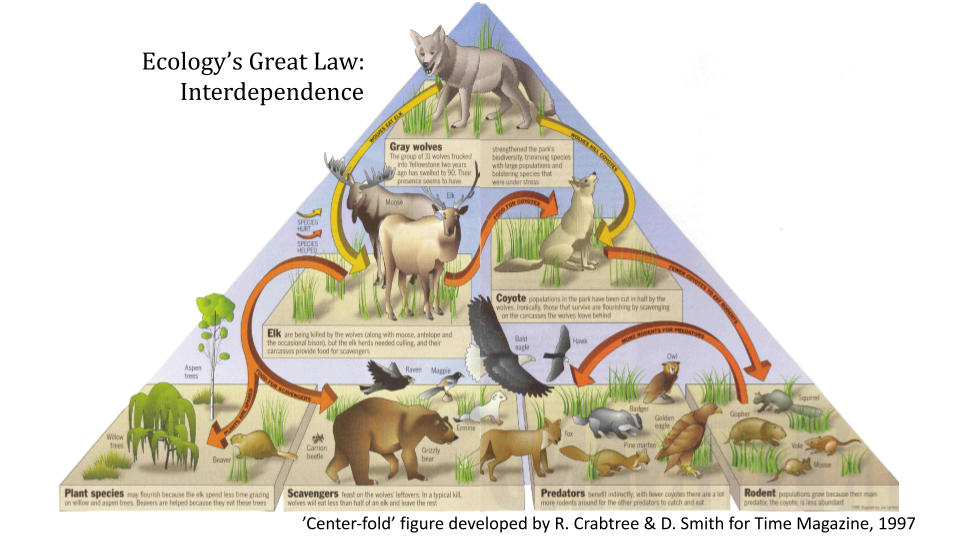A Call for Evidence: Why are We Killing off one of our Greatest Assets in Greater Yellowstone?
YERC’s Chief Scientist, Dr. Bob Crabtree, recently briefed the Council on Environmental Quality at the White House about the “science, evidence, and common sense” of the wolf controversy in Montana and Idaho. While that presentation was not allowed to be recorded, we’ve included excerpts from the presentation below.
I grew up in north Idaho and first started working in Yellowstone after the great fires of 1988. I built a wolf population model that accounted for social class and family structure as part of the enormous environmental impact statement (EIS) process in 1991. This had not been done before and a highly social species needs that approach and I have been studying wolves and their ecological impacts ever since. This kind of science was also used to make the predictions illustrated in this cartoon used by thousands of teachers and students across the US.
Collectively all of our predictions basically came true. We were right. We used science back then for wolf decision-making and, sadly, we don’t today. And there are three examples of this:
1. We need to measure wolves and we don’t anymore. Soon after delisting, the best available scientific method to count them was abandoned by the political leaders of otherwise good fish and game agencies. The method used in Idaho, for example, is both biased and imprecise. It’s like a nervous, shaky-handed hunter shooting a rifle at a target with a curved barrel. Can you imagine going to court with such weak evidence? Managing your business without knowing what stock you have on your shelves? Why should it be any different for our nation’s imperiled wildlife.
2. Wolves provide many benefits to humans by keeping the ecosystems - that we humans rely upon - healthy. Apex predators, like wolves, have a disproportionately large influence on ecosystems. With few species at naturally occurring low densities at the top of the food chain (see figure), they and ecosystem health are highly vulnerable. Thus, the most effective way to decimate an ecosystem is to kill the large carnivores. Likewise, however, reintroducing them may be the most cost-effective way to restore that health and benefit to humankind. That’s what we did and that’s what we saw in Yellowstone. Science has given us a long list of benefits to ecosystems as well as direct benefits to humans such as keeping game populations healthy like deer and elk, restoring vegetation, and reducing disease transmission, and more….
3. At this time wolves do have negative impacts on society, mainly predation on livestock; but the news couldn’t potentially be better. Here’s why: we now have so many solutions to reduce or eliminate predation on livestock. They are not perfect, but if we empower private landowners like ranchers to actually apply these tools and practices, science has shown that it’s often a triple win – a win for wolves and ecosystems, a win for private landowners (and public land managers) and an economic win because they can increase their profit margins.
So there you have it. We are flying blind as we ignore science, facts, and common sense. We don’t even know how many wolves we have in the Northern Rockies. We ignore their benefits to society as well as their value to ecosystems. And what small negative impacts wolves have on domestic livestock can be reduced or eliminated with coexistence practices.
So, if we evaluate wolf killing based on the three “E’s”: Ecology, Economics, and Ethics, we can’t justify the choice to kill. Even if we look at each E individually. The evidence suggests the only benefit of killing is for sport killing. I understand that because I used to. We weigh the evidence in courts and we use it to run successful businesses. In the spirit of NEPA, we require the perpetrator to justify their actions and make the right choice. So why can’t we use the best available science for wolf management decisions?
Besides a few protected areas, there is a complete lack of using best available science as stipulated in the Endangered Species Act for decision-making. Evidence, the fuel of science, is being flatly ignored and drowned out with misinformation campaigns.
Dr. Crabtree’s long term research and monitoring is part of our WildNET program - support WildNET by donating here.


